Through this blog post, we’re going to take a look at the potential to head out Foraging for Invasives. What is an invasive species, what to look for and some top tips for helping control these species whilst getting a bangin meal at the same time!
The spread of so-called invasive plant and animal species has been a major concern for wildlife conservation in the UK in recent decades. These are species that have originated somewhere else in the world and brought here either on purpose, as crops or as garden plants; or by accident, perhaps as seeds mixed in with ships ballast or some other cargo.
Of course, hundreds of non-native species have been brought in by people over the millennia and most don’t actually pose any problem at all – any gardener or farmer knows it’s actually quite hard to keep most of them alive, let alone get them to spread! So in order to be considered ‘invasive’ a plant has to be really very aggressive in its spread, and cause problems while its at it. Very few are well adapted to our climate enough to manage this , but when they do…well. They can out-compete native species, changing the balance of delicate ecosystems and reducing overall biodiversity.
The reduction in diversity of native plants has knock-on effects for the insects and animals that feed on them, and so on throughout the food chain. Other downsides can include destabilising soil (Himalayan Balsam) clogging up waterways (Floating Pennywort) or causing harm to human health (Giant Hogweed).
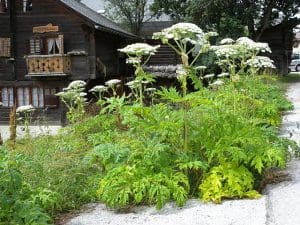
So there are good reasons why people might want to try and control the spread of these particular plants, much as it’s probably fair to say they are here to stay. So we may as well make the best of it – here are a few on the naughty list that actually can be eaten as one method of control. I’ll also be including some tips on how to avoid accidentally spreading them while harvesting. Schedule 9 to the Wildlife and Countryside Act 1981 with respect to England and Wales has a list of the really problematic species, and states that it is an offence to plant or otherwise allow these species to grow in the wild, so please DO NOT plant any of these on purpose no matter how much you like the flavour. If you think you can keep just a little bit contained in your veg garden, that would be a huge mistake – they are called Invasive for a reason and will almost certainly get out of control and escape! (and its not like they are hard to find out in the wild already anyway…)
Extra helpful information on Foraging for Invasives
If you want to learn more, the GB Non-Native Species Secretariat has some great ID guides for a much broader range of species than I’m talking about here, and data on the impact they are having.
So, what about cooking for conservation?
Click on the plant names below for a link to our identification guides, and read on for some ideas on how to use them.
Himalayan Balsam Impatiens glandulifera
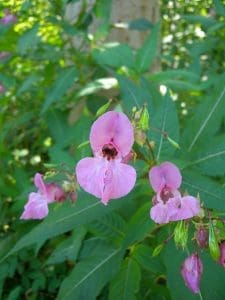
Eat the flowers raw in salad, use the hollow stems as drinking straws, and my favourite part – try and catch the seeds from the exploding seed pods, to eat raw or toasted as a delicious nutty snack, sprinkle ar ingredient in seedy bakes. The trick to catching more of them (and letting less fly off to spread) is to deftly put a bag over the top of the plant and shake it, letting the pops explode inside. The little green bits of pod arent toxic, but you might want to separate them out before storing the seeds in a jar if you arent using them straight away.
Every stem you pull up, and every flower and every seed you eat means marginally less balsam plants in the future. So have at it!
*** Stop the Spread: Its the explosive seeds flying everywhere that are the biggest risk – try to catch as many as you can and carefully check and clean the treads of your footwear when leaving the patch so that you don’t accidentally traipse them along your route home***
Japanese Knotweed, Fallopia japonica
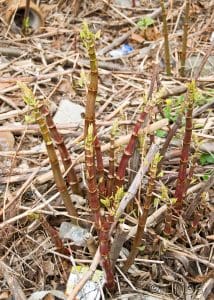
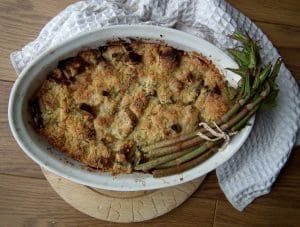
It can punch through concrete and get into the foundations of buildings, drastically reducing house price if its found on your garden even a long way from the house. This is because it can spread so fast and is so eye-wateringly expensive to get rid of – the soil needs to be taken away to a depth of several metres to be sure. It can be sort of controlled by repeated applications of the powerful weedkiller glyphosate – this is carcinogenic so make sure to avoid eating any that has been sprayed. Usually it will be pretty obvious that the plant is going yellow, growing stunted and generally looking sorry for itself, but to be sure you could also ask the landowner if there has been any spraying.
Once you’ve found a healthy untreated patch, Its the tender new Spring shoots that you want to forage – they taste a bit like rhubarb and can be used in all the same ways.
Find more Japanese Knotweed Recipes here
***Stop the Spread: Japanese knotweed can re-grow from the smallest fraction of living stem, leaf or root. So be extra careful with any offcuts and never drop them on the walk home. Offcuts are actually classified as controlled waste, so never put them in the bin or compost without microwaving them into oblivion first – or you could just burn them! ***
Few flowered leek, Allium paradoxum and Three-cornered leek, Allium triquetrum
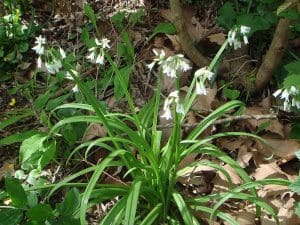
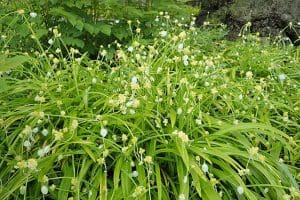
These are two different members of the onion family. They look slightly different – click on the names to go to the ID guides and compare the two – but they are both invasive and both can be used in similar ways. They can be used like spring onions, raw in salads, lightly cooked in stir fries. Or you can fry them up at the start of any number of dishes in place of onion, Leeks and garlic – the flavours are somewhere in between the three in my opinion.
https://totallywilduk.co.uk/2022/02/10/three-cornered-leek-wilted-hogweed-stem-with-peas/
https://totallywilduk.co.uk/2020/05/14/tuna-pasta-with-wild-garlic-and-three-cornered-leek/
Or swap them in to any of these Wild Garlic recipes!
https://totallywilduk.co.uk/wild-garlic-recipes/
And much as you still technically need landowners permission to dig up and eat the bulbs, these are one of the few plants where it would help the environment if you dug up and used as many as possible.
*** Stop the spread: do NOT put bulbs or seeds in the green bin or in your compost***
Here are some more species to consider when Foraging for Invasives
Japanese Rose, Rosa rugosa
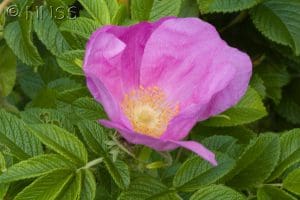
– Copyright GBNNSS
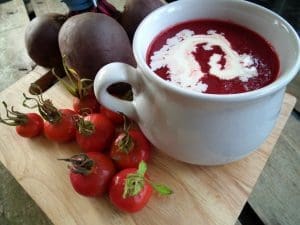
The petals can be eaten raw just like our native Dog rose – but they are much more strongly perfumed and flavoured, so I preferentially use Japanese rose if I can when making turkish delight or flavoured alcohols.
The hips can also be used in any rosehip recipe. Being much bigger and fleshier , it takes much less time to gather enough – I can get several kilos in ten minutes from a good patch.
https://totallywilduk.co.uk/wild-rose-recipes/
***Stop the Spread*** do not drop seeds in your compost or green bin. To be on the safe side, kill them off by boiling or microwaving***
Ground Elder, Aegopodium podagraria
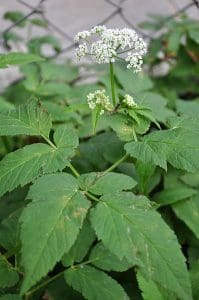
Thought to have been introduced by the Romans precisely because its so tasty, it’s become the bane of many gardeners, always popping back up from tiny snapped-off root fragments no matter how many times its pulled up. The smallest leaves and new shoots are delicious raw, tasting somewhere between carrot and celery. The mature leaves are tougher and need to be cooked, but make a great addition to stews and curries
***Stop the Spread: be careful not to get any fragments into your compost – it can spread from tiny pieces of root left behind. Avoid picking the seeds***
And finally…. One you probably shouldnt forage!
Giant Hogweed, Heracleum mantegazzianum

Some say the seeds are technically edible, but with the very real risk of horrible chemical burns from the sap, I tend to leave this one alone! Use the native Common Hogweed instead.
***Stop the Spread*** Call you local council to cut off the flowers or immature seed heads to stop mature seeds from blowing on the wind. This is a job for the professionals as high levels of protective clothing are needed to cut it down and dispose of it safely.
To Conclude Foraging for Invasives
In conclusion, foraging for invasives in the UK can be a great way to help control the spread of harmful plants while also enjoying delicious and unique meals.
While it is important to be aware of the potential risks associated with certain species, such as the harmful effects of Giant Hogweed sap, with proper identification and precautions, foraging for invasives can be a fun and sustainable way to contribute to conservation efforts. By pulling up a Himalayan Balsam plant or collecting the seeds of Japanese Knotweed, you can make a small but meaningful impact on the environment. So get out there, explore, and try some new recipes using these underappreciated wild foods.
Just remember to always prioritize safety, and be mindful of not accidentally spreading invasive species further.





